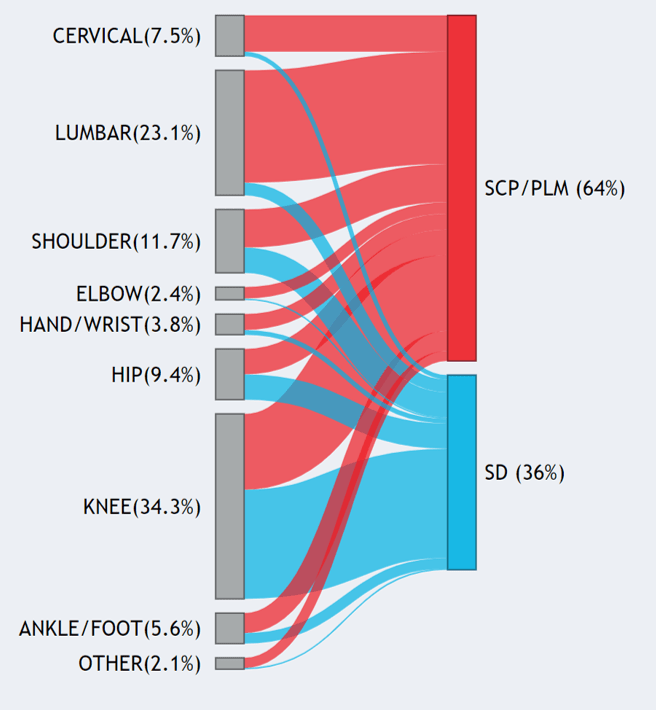How Many Patients Get PRP vs. BMC?

A big question I get from patients is should I get PRP or a Bone Marrow Concentrate procedure? This morning we’ll go over data from our treatment registry that shows what tens of thousands of patients have gotten since 2005. Let’s dig in.
PRP vs BMC
PRP stands for platelet-rich plasma. That’s concentrated blood platelets in plasma that works by the precisely timed release of growth factors and exosomes to help heal wounds and injuries. BMC stands for Bone Marrow Concentrate which is concentrating the cellular fraction of your bone marrow aspirate. It works in a similar fashion to PRP, but since it also contains stem cells, it’s thought to have other healing properties which can include those cells turning into needed cells in the repair area.
How Many Patients Got Which Procedure?
Out of 57,196 patients above, to the right, you see “SCP/PL” which stands for “Super Concentrated Platelets” (our version of highly concentrated leukocyte poor PRP) and PLM (“platelet lysate”-the growth factors stripped from platelets). SD stands for “Same Day” which is a Bone Marrow Concentrate (BMC) procedure containing stem cells. Both of these are highly complex medical procedures involving precise imaging guidance. As you can see, about 2/3 of patients (64%) got a platelet-based procedure and about 1 in 3 (36%) got a BMC procedure.
Our Provider Network
This data represents 35,000+ platelet-based and bone marrow procedures performed since 2005 by our national provider network. We now have about 70 clinics here in the US. The actual treatment numbers are higher, as the platelet joint procedures (like the knee) weren’t tracked until approx the past five years ago, so total procedures performed are well over 50,000.
Here’s a map of where these patients come from:

How About Body Areas?
Above you can see the breakdown of each procedure type (PRP in red and BMC in blue) for each body area to the left. On the left are the percentages of the total that represent that body area.
For example, 23.1% of our total patients were lumbar with the vast majority getting platelet-based treatments. Why not more BMC spine treatments? Because in my experience, our version of less expensive platelet-based procedures work well enough in the spine, that unlike other clinics, there just is no reason to use BMC. Having said that, there are a few clinical scenarios when we may use BMC, including a tear in the disc with pain caused by the damage. You see the same trends for the neck as well. Our national network treats about three back pain for every one neck pain patient.
The most popular body area we treat is the knee at 34.3% of the total. Also note that here, it’s about 60% BMC and 40% platelets. That’s because most of our knee patients who get evaluated have more severe knee arthritis where PRP is less effective. The patients getting PRP in this graph have less severe mild/moderate knee arthritis, where it works very well.
This is the frequency of what we inject (highest to lowest):
- Knee
- Lumbar
- Shoulder
- Hip
- Cervical
- Ankle/Foot
- Hand/Wrist
- Elbow
- Other
Why Don’t You See This Type of Data Anywhere Else?
You don’t see it, because this data isn’t usually collected by other clinics. However, you should expect to see it. Why? In this case, it helps you see that for many of our patients, lower-priced and less invasive platelet-based procedures get the job done. So while we could be slamming everyone into high-priced and more invasive bone marrow procedures, that’s not how we roll.
The upshot? As you can see, we’re transparent now and always have been. We want all of our patients to know what most patients get done, which joints we treat, and how often. This is the type of information you should expect and when you don’t see it elsewhere, chose Regenexx.

If you have questions or comments about this blog post, please email us at [email protected]
NOTE: This blog post provides general information to help the reader better understand regenerative medicine, musculoskeletal health, and related subjects. All content provided in this blog, website, or any linked materials, including text, graphics, images, patient profiles, outcomes, and information, are not intended and should not be considered or used as a substitute for medical advice, diagnosis, or treatment. Please always consult with a professional and certified healthcare provider to discuss if a treatment is right for you.
